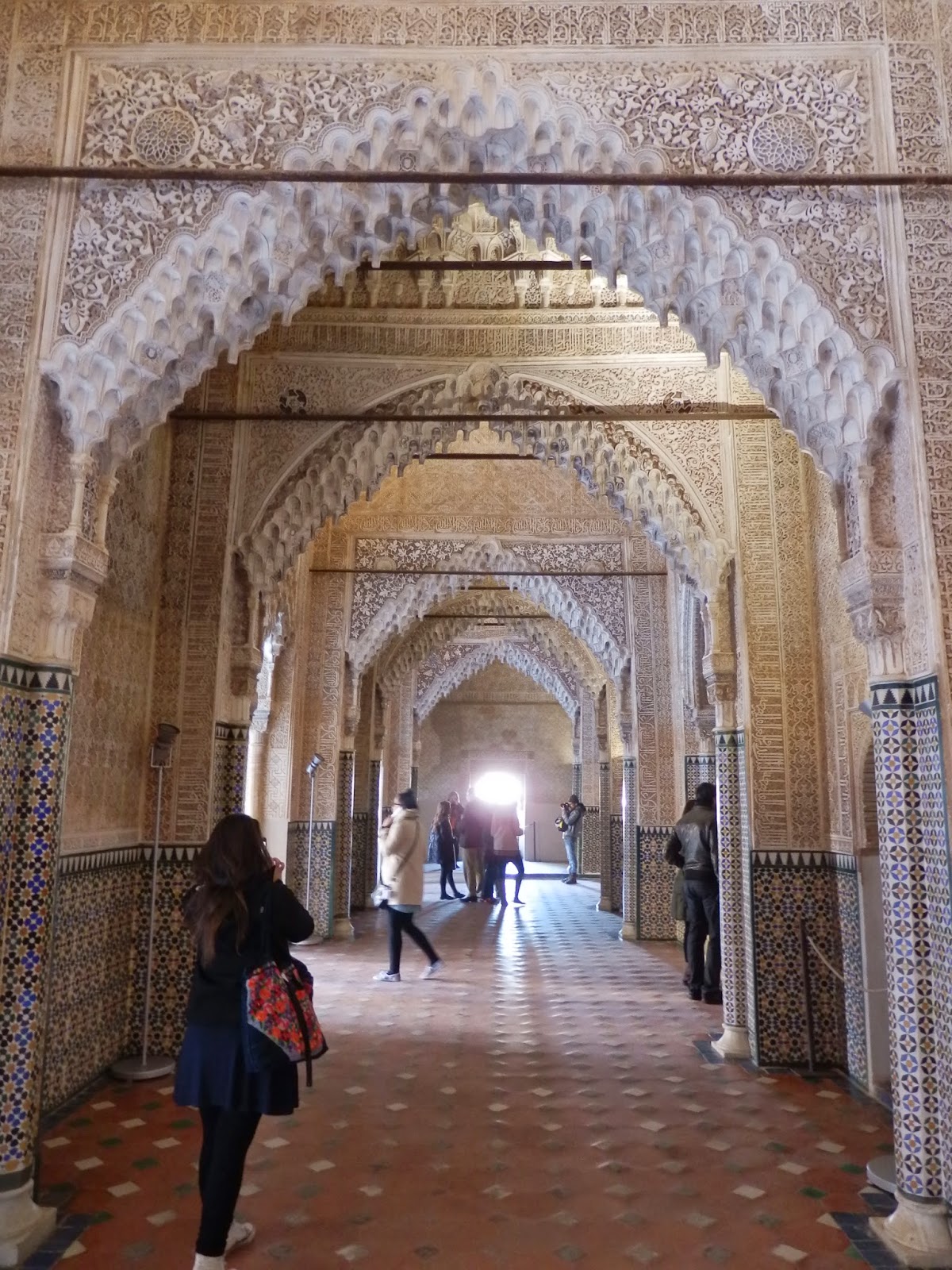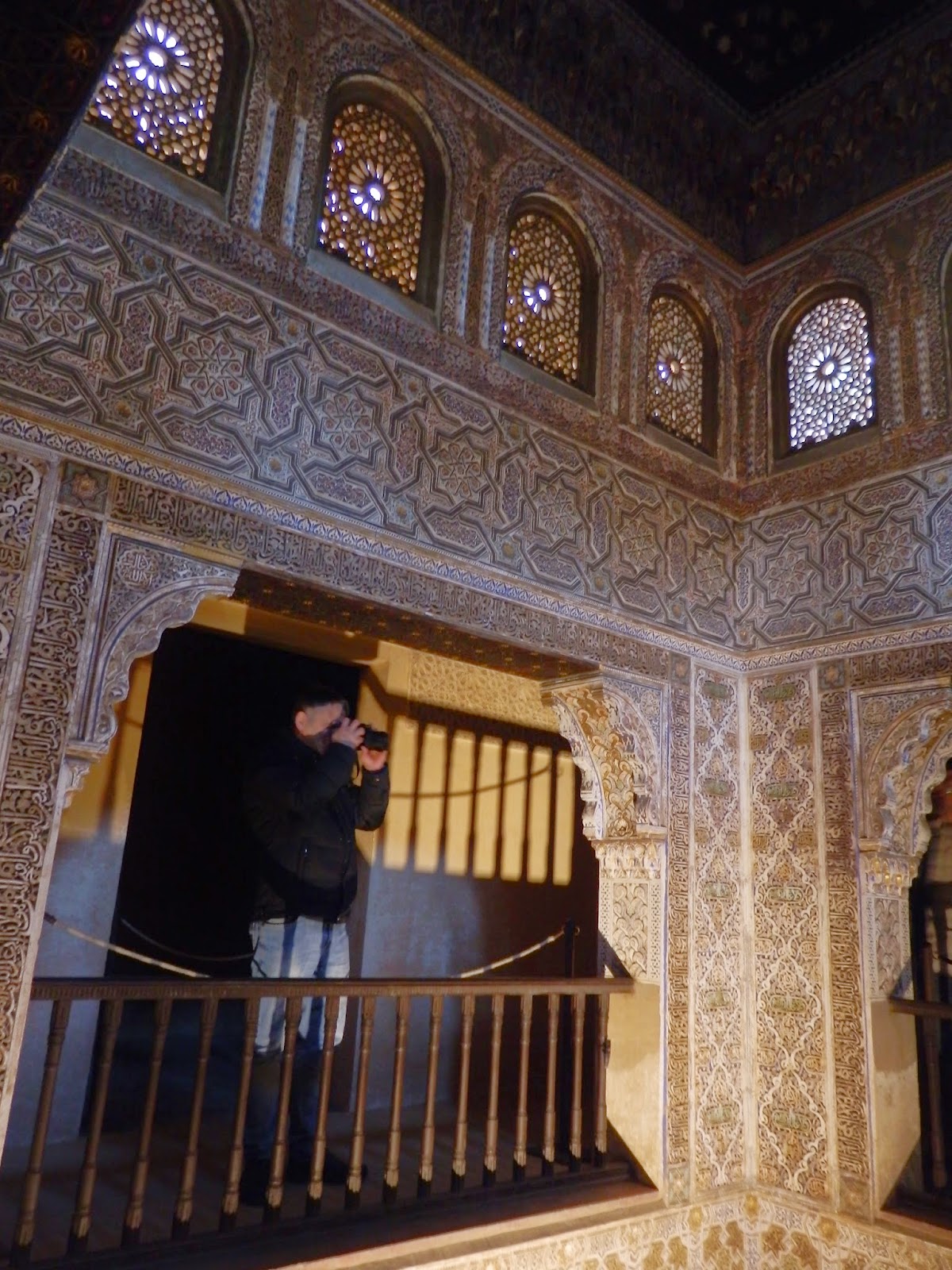Giving us one day to settle in, Mum organised for our trip to the Alhambra to be for our second day in Granada.
Entry into the Nasrid Palaces within the Alhambra complex is by times entry only and the entry to the Palace is a bit of a walk from the front gate.
Having bought tickets for a 9:30 entry, Mum was insistent that we be there in time. Not only in good time, but with enough time to spend at least half an hour in the cold morning air waiting for our turn, trying to coax the cats in the area to get out of the tree (its toesies were cold to) and come and entertain us. Strangely they were only open to bribery and we had no food to share.
We did find sunshine though. Knowing it would be a warm day, we had not bothered to bring our coats with us which meant that for part of the morning we were chasing the sun around the garden.
The palaces were beautiful and for once I was relatively impressed with the quality of the tourists.
The Mexuar Palace:
 |
| The Sala del Mexuar |
 |
| Looking through to the Courtyard of the Cuarto Dorado |
 |
| The Oratory |
 |
| Looking from within the Portico of the Cuarto Dorado at the Facade of the Palacio de Comares |
Palacio de Comares
 |
| Sala de la Barca |
 |
| Northern Facade and Torre de Comares |
 |
| In the Patio de los Arrayanes |
 |
| Salon del Trono |
 |
| The ceiling of the Salon del Trono taken on a night-time setting. |
In many places where there are certain angles or position from which you want to take photos, we seemed to work together either taking it in turns to capture our shots and then carefully moving on, or all sitting together huddled above or around each other waiting for that one tourist to move so you’d get a clear shot. I found that even the guards were kind enough to keep out of the way of some of the more major shots across the Lion’s courtyard.
 |
| View into the Patio de los Leones (Lion's Courtyard) |
 |
| Sala de los Reyes |
 |
| Mirador de Lindaraja |
 |
| Sala de Dos Hermanas |
It means I got some great pictures of the Lion’s courtyard with few or no people. Although the walls and ceilings within the Alhambra are intricately decorated, much of the colour has been lost over time resulting in only the occasional splash in the otherwise white carved patterns and honeycombed ceilings.
 |
| Ceiling of the Sala de Dos Hermanas |
Only one room was highly coloured, This is the Hamman, the baths of the Palacio de Comares.
Throughout the palace the floors appeared to have been either of polished marble or terracotta, interspersed with smaller tiles decorated with patterns or the pomegranate that is the emblem for the area. Typically, this tile was one of the things not reproduced in the palace shop. I did manage to find a reproduction of an 1842 sketch of one of the rooms we visited. What was nice was that the sketch implied (or imagined) that the courtyards were filled with potted plants and carpets and cushions were laid in various corners for the purpose of lounging and enjoying the view.
One of the intriguing things about the Alhambra was the amount of running water that was everywhere. There must have been a natural spring in the area as marble fountains and ponds were everywhere.
Looking out from the windows of the Alhambra gave us a view down the cliff face/valley and then across to the terraces and up to the Mirador San Nicolas where we had found icecream the day before.
Granada is famous for its Granadas (pomegranates to English speakers) and real and ornamental trees were scattered throughout the gardens, along with persimmons...
While the Nasrid Palaces were the main drawcards of the alhambra, there are a few other attractions in this mountain plateau. One is the tower walls of the Alcazabar enclosing the archeological remains of a former palace/town/...
The strangest looking building was the Palace of Carlos V. On the outside, the building is almost a typical square Baroque palace, completely at odds with the Moorish medieval palaces of the Alhambra and Alcazabar. On the inside, it was a series of rooms around two stories of a circular courtyard adorned with marble pillars and arches. It was interesting to wonder what the building would have been like when it was inhabited. Was this the space for promenades, or an open air corridor between the rooms. Was it more of a festivity room with concerts or even political discussions. It was a little difficult to check the acoustics of the room and I’ll admit I had failed to undertake the necessary research before visiting.





Having viewed much of this half of the mountain top, we wandered around to the Generalife. It is a series of gardens (and a less impressive building) separated from the rest of the Alhambra by a partial deep valley. Like much of the Alhambra, the gardens here were beautiful, sunlit lines of ponds interspersed with fountains and conifers. All rather beautiful but difficult to replicate given the extensive use of space and heavy white marble.
There were also a few terraced hedged gardens of dormant roses and a shaded avenue made up of the very poisonous Oleander. No wonder there were signs everywhere saying ‘Do not touch the plants.’
Having not really eaten lunch that day, what with being in and out of palaces, we went out for dinner to a lovely little restaurant just around the corner from our apartment. Beautiful food!














































































No comments:
Post a Comment